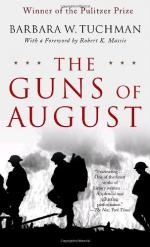
|
| Name: _________________________ | Period: ___________________ |
This test consists of 15 multiple choice questions and 5 short answer questions.
Multiple Choice Questions
1. If Schlieffen wanted to be bold in his plans, what did Moltke want to do?
(a) Not be too bold.
(b) Be even bolder.
(c) Be fearful.
(d) Be reckless.
2. How many corps did the German army have?
(a) 50.
(b) 10.
(c) 30.
(d) 40.
3. Why did the Belgians not have any heavy artillery?
(a) The Austrian company hired to make it had botched the job.
(b) The Belgians had scoffed at the idea of heavy artillery.
(c) The Russian company hired to make it had requisitioned it for war.
(d) The German company hired to make it had delayed deliveries.
4. What former U.S president was present at the funeral of Edward VII?
(a) Woodrow Wilson.
(b) Calvin Coolidge.
(c) Ulysses S. Grant.
(d) Theodore Roosevelt.
5. The artful, indolent, pleasure-loving Sukhomlinov was the Minister of War for what country?
(a) Germany.
(b) Russia.
(c) Austria.
(d) England.
6. What did the book The Great Illusion try to prove?
(a) That war made you strong.
(b) That war was a human necessity.
(c) That war had become vain.
(d) That war was inconvenient.
7. Who was the Home Secretary of Britain when the war began?
(a) Sir Edward Grey.
(b) Winston Churchill.
(c) Joseph Joffre.
(d) Sir Henry Kitchener.
8. What event took place two hours after Grey finished speaking to the House of Commons in Chapter 9?
(a) Germany declared war on France.
(b) Russia declared war on Austria.
(c) France declared war on Germany.
(d) Belgium declared war on Britain.
9. The German ultimatum to what country expired at noon on Saturday, August 1?
(a) England.
(b) Serbia.
(c) Russia.
(d) France.
10. What was the one precaution the German commanders did not plan for?
(a) Rest.
(b) Supplies.
(c) Flexibility.
(d) Train traffic.
11. Why did the French insist that Russia attack by the 15th day of war, regardless of its readiness?
(a) They knew Britain would join them if the Russians did.
(b) They wanted Germany to leave them alone.
(c) They wanted Germany to be forced to fight on two fronts.
(d) They knew Russia would utterly defeat the Germans.
12. What was “an unimportant obstacle” (18) to Schlieffen, along with the River Pregel?
(a) Belgian neutrality.
(b) The Rhine River in Germany.
(c) War with France.
(d) The road home.
13. What does King Albert decide to try after Germany refuses to respond to formal messages to prevent a war?
(a) He decides to try a private appeal to the Kaiser.
(b) He decided to raise more soldiers and prepare for war.
(c) He decided to try a private phone call with the Kaiser.
(d) He decided to visit Berlin to calm things down.
14. What did Foch say was the first condition of victory?
(a) The desire for freedom.
(b) The destruction of the enemy.
(c) The will to conquer.
(d) The discipline of war.
15. How did Clausewitz claim one could win public opinion?
(a) By gaining victories and the enemy’s capital.
(b) By outspending your opponents.
(c) By giving the people what they want.
(d) By outsmarting your opponents.
Short Answer Questions
1. Whose funeral sets the scene in Chapter 1?
2. Why did the German General Staff believe that Britain belligerency would not affect the war?
3. Who was the ninth king attending Edward VII’s funeral whom “few observers had eyes for” (3)?
4. What state were the Belgian troops in when war was declared?
5. What is the bigger a division or a corps?
|
This section contains 639 words (approx. 3 pages at 300 words per page) |

|




